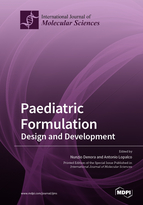Paediatric Formulation: Design and Development
A special issue of International Journal of Molecular Sciences (ISSN 1422-0067). This special issue belongs to the section "Molecular Toxicology".
Deadline for manuscript submissions: closed (30 June 2020) | Viewed by 53015
Special Issue Editors
Interests: drug delivery; drug targeting; TSPO; imaging; tumors
Special Issues, Collections and Topics in MDPI journals
Interests: drug delivery; nanotechology; drug stability; paediatric formulation
Special Issues, Collections and Topics in MDPI journals
Special Issue Information
Dear Colleagues,
The development of paediatric medicines can be challenging since this is a diverse patient population with specific needs. A medicine designed for use in paediatric patients must consider the following aspects: patient population variability; the need for dose flexibility; route of administration; patient compliance; excipient tolerability. For example, the toxicity of excipients may differ in children compared to adults and children have different taste preferences.
Globally, about 75% of drugs do not carry regulatory approval for use in children; worldwide, many medications prescribed for the treatment of paediatric diseases are used off label, and less than 20% of package inserts have sufficient information for treating children.
The aim of this Special Issue is to provide an update on both state-of-the-art methodology and operational challenges in paediatric formulation design and development. It aims at re-evaluating what is needed for more progress in the design and development of age-appropriate treatments for paediatric diseases.
We welcome original research, review, opinion papers, editorials, or short communications on the following topics:
- paediatric formulation development;
- drug delivery design in paediatrics;
- orphan drugs;
- pharmacology and toxicology of drugs and excipients in paediatrics.
Prof. Dr. Nunzio Denora
Dr. Antonio Lopalco
Guest Editors
Manuscript Submission Information
Manuscripts should be submitted online at www.mdpi.com by registering and logging in to this website. Once you are registered, click here to go to the submission form. Manuscripts can be submitted until the deadline. All submissions that pass pre-check are peer-reviewed. Accepted papers will be published continuously in the journal (as soon as accepted) and will be listed together on the special issue website. Research articles, review articles as well as short communications are invited. For planned papers, a title and short abstract (about 100 words) can be sent to the Editorial Office for announcement on this website.
Submitted manuscripts should not have been published previously, nor be under consideration for publication elsewhere (except conference proceedings papers). All manuscripts are thoroughly refereed through a single-blind peer-review process. A guide for authors and other relevant information for submission of manuscripts is available on the Instructions for Authors page. International Journal of Molecular Sciences is an international peer-reviewed open access semimonthly journal published by MDPI.
Please visit the Instructions for Authors page before submitting a manuscript. There is an Article Processing Charge (APC) for publication in this open access journal. For details about the APC please see here. Submitted papers should be well formatted and use good English. Authors may use MDPI's English editing service prior to publication or during author revisions.








